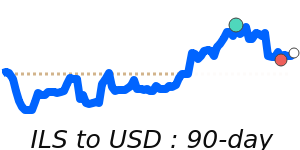Recent forecasts and market updates indicate a mixed outlook for the USD/ILS exchange rate, shaped by developments in both the U.S. and Israeli economies. The U.S. dollar has recently seen modest gains as it rebounded from multi-month lows, influenced by price-conscious investors. However, expectations of aggressive interest rate cuts by the Federal Reserve in 2026 are putting downward pressure on the dollar. Analysts note that a softer inflation print or other dovish signals from the Fed could further weaken the USD.
Simultaneously, economic data shows a slowing growth trajectory in the U.S., particularly with hints of manufacturing weakness and decelerating consumer spending. Yet, a resilient labor market provides some support for the USD, suggesting limited downside potential despite current bearish sentiments. Market observers expect the USD to remain range-bound as global risk sentiment stabilizes, with upcoming economic indicators likely influencing its trajectory.
In Israel, the shekel has been gaining strength against the dollar, bolstered by a decline in the inflation rate, which fell to 2.5% in September 2025, within the Bank of Israel's target range. This cooling inflation could prompt potential interest rate cuts, further supporting the shekel’s gains. A recent UBS forecast revision reflects confidence in the shekel's strength, indicating a downward adjustment of USD/ILS projections amid reduced geopolitical risk.
Currently, the USD/ILS exchange rate sits at 3.2228, approximately 1.7% below its three-month average of 3.2769, having fluctuated within a stable range of 3.2003 to 3.3576. As analysts highlight the combined effect of U.S. rate cuts and Israeli economic fundamentals, it appears that the shekel may continue to appreciate against the dollar in the medium term. Overall, the interplay between U.S. monetary policy and Israeli economic conditions is expected to guide the USD/ILS exchange rate movements in the coming weeks.


